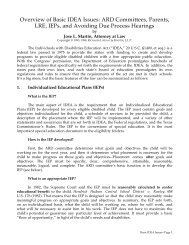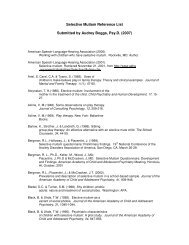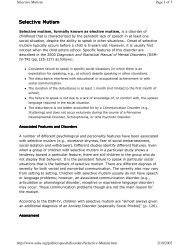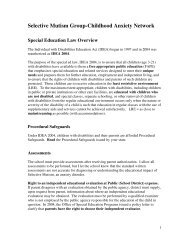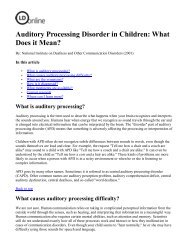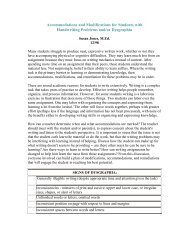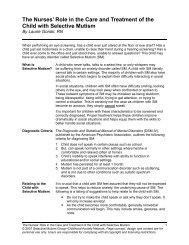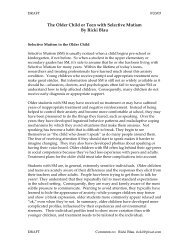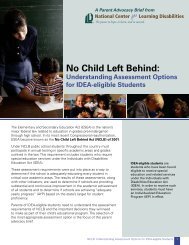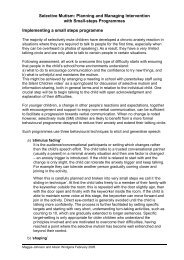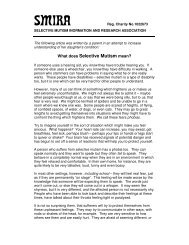SELECTIVE MUTISM REFERENCE LIST
SELECTIVE MUTISM REFERENCE LIST - Selective Mutism Group
SELECTIVE MUTISM REFERENCE LIST - Selective Mutism Group
- No tags were found...
Create successful ePaper yourself
Turn your PDF publications into a flip-book with our unique Google optimized e-Paper software.
<strong>SELECTIVE</strong> <strong>MUTISM</strong> <strong>REFERENCE</strong> <strong>LIST</strong>Provided by SMIRA (Selective Mutism Information and Research Association)Adams, J., & Glasner, P. (1954). Emotional involvement in some forms of mutism.Journal of Speech and Hearing Disorders, 19, 59-69.Adams, M. (1970). A case of elective mutism. Journal of the National MedicalAssociation, 62, 213-216.Afnan, S., & Carr, A. (1989). Interdisciplinary treatment of a case of electivemutism.British Journal of Occupational Therapy, 52, 61-66.Albano, A.M., & Silverman,W. K. (1996). Anxiety disorders interview schedule forDSM-IV: Child version. Clinician Manual. San Antonio, TX: The PsychologicalCorporation, Harcourt Brace.Albert-Stewart, P. L. (1986). Positive reinforcement in short-term treatment of anelectively mute child : a case study. Psychological Reports, 58, 571-576.Allen, A., Leonard, H., & Swedo, S. (1995). Current knowledge of medications for thetreatment of childhood anxiety disorders. Journal of the American Academy of Childand Adolescent Psychiatry, 34, 976–986.Altschuler, L., Cummings, J., & Mills, M. (1986). Mutism: Review, differentialdiagnosis, and report of 22 cases. American Journal of Psychiatry, 143, 1409–1414.Ambrosino, S.V., & Alessi, M. (1979).Elective mutism: Fixation and the double blind.American Journal of Psychoanalysis, 39, 251-256.American Psychiatric Association (1994). Diagnostic and Statistical Manual ofMental Disorders, 4th edition (DSM-IV). Washington, DC: American PsychiatricAssociation.American Psychiatric Association (1996). Manuel diagnostique et statistique destroubles mentaux (DSM-IV). Trad. fr. Paris, Milan, Barcelone, Paris: Masson.Andersson, C. B., & Thomsen, P. H. (1998). Electively mute children: an analysis of 37Danish cases. Nord Psykiatr Tidsskr, 52, 231–238.Anstendig, K. (1998). Selective mutism : A review of the treatment literature by1
modality from 1980-1996, Psychotherapy 35(3), 381–391.Anstendig, K.D. (1999). Is selective mutism an anxiety disorder? Rethinking its DSM-IV classification. Journal of Anxiety Disorders, 13, 417–434.Anthony, E. J. (1977). Nonverbal and verbal systems of communication: A study incomplementarity. Psychoanalytic Study of the Child, 32, 307–325.Atlas, J. (1993). Symbol use in the case of selective mutism. Perceptual and MotorSkills, 76, 1079–1082.Atoynatan, T. H. (1986). Elective mutism: Involvement of the mother in thetreatment of the child. Child Psychiatry and Human Development, 17, 15-27.Aubry, C., & Palacio-Espasa, F. (2002). Le mutisme sélectif, Psychiatrie de l’enfant,XLVI, 1, 187- 207.Austed, L. S., Sininger, R., & Stricken, A. (1980). Successful treatment of a case ofelective mutism. Behavioral Therapist, 3, 18-19.Baldwin, S., & Cline, T. (1991). Helping children who are selectively mute. Educationand Child Psychology, 8, 72–83.Barlow, K., Strother, J., & Landreth, G. (1999). Sibling group play therapy: Aneffective alternative with an elective mute child. In S. A. Spasaro & C. E. Schaefer(Eds.), Refusal to speak: Treatment of selective mutism in children (pp. 219-229).Northvale, NJ: Jason Aronson.Bauermeister, J. J., & Jemail, J. A. (1975).Modifications of “elective mutism” in theclassroom setting:A case study. Behavior Therapy, 6, 245-250.Bednar, R. A. (1974).Abehavioral approach to treating an electivemute in school.Journal of School Psychology, 12(4), 326-336.Beidel, D. C. (1991), Social phobia and overanxious disorder in school-age children. JAm Acad Child Adolesc Psychiatry, 30, 545–552.Bergman, R. L., Keller, M., Wood, J., Piacentini, J., & McCracken, J. (2001), SelectiveMutism Questionnaire (SMQ): development and findings. Poster session presentedat the meeting of the American Academy of Child and Adolescent Psychiatry,Honolulu, October.Bergman, R. L., Piacentini, J., & McCracken, J.T. (2002). Prevalence and descriptionof selective mutism in a school-based sample. Journal of the American Academy of2
Child and Adolescent Psychiatry, 41, 938–946.Bernstein, G. (1991). Comorbidity and severity of anxiety and depressive disordersin a clinic sample. Journal of the American Academy of Child and AdolescentPsychiatry, 30, 43–50.Bernstein, G. A., & Garfinkel, B. D. (1988). Pedigrees, functioning, andpsychopathology in families of school phobic children. American Journal ofPsychiatry, 145, 70-74.Biederman J, Rosenbaum JF, Bolduc-Murphy EA et al. (1993), A three-year follow-upof children with and without behavioral inhibition. Journal of the American Academyof Child and Adolescent Psychiatry, 32, 814–821.Birmaher, B., Waterman, S., Ryan, N., Cully, M., Balach, L., Ingrahm, J., & Brodsky, M.(1994). Fluoxetine for childhood anxiety disorders. Journal of the American Academyof Child and Adolescent Psychiatry, 33, 993–999.Black, B., & Uhde, T. (1992). Elective mutism as a variant of social phobia. Journal ofthe American Academy of Child and Adolescent Psychiatry, 31, 1090–1094.Black, B., & Uhde, T. (1994). Treatment of elective mutism with fluoxetine: Adouble-blind, placebo- controlled study. Journal of the American Academy of Childand Adolescent Psychiatry, 33, 1000–1006.Black, B., & Uhde, T. (1995). Psychiatric characteristics of children with selectivemutism: A pilot study. Journal of the American Academy of Child and AdolescentPsychiatry, 34, 847–856.Blake, P., & Moss, T. (1967). The development of socialization skills in an electivelymute child. Behavior Research and Therapy, 5, 349-356.Blotcky, M., & Looney, J. G. (1980). A psychotherapeutic approach to silent children.American Journal of Psychotherapy, 34, 487-495.Blum, N. J., Kell, R. S., Starr, H. L., Lender, W. L., Bradley-Klug, K., Osborne, M. L., etal. (1998). Case study: Audio feedforward treatment of selective mutism. Journal ofthe American Academy of Child and Adolescent Psychiatry, 37, 40-43.Boon, F. (1994). The selective mutism controversy (continued). Journal of theAmerican Academy of Child and Adolescent Psychiatry, 33, 283.Boyle, M.H., Cunningham, C.E., Heale, J., Hundert, J., McDonald, J., Offord, D.R., &Racine, Y. (1999). Helping children adjust – A Tri-Ministry Study: I. Evaluation3
Methodology. Journal of Child Psychology and Psychiatry, 40, 1051–1060.Bozigar, J. A., & Hanson,R.A. (1984).Group treatment of elective mute children.Social Work, 29, 478-480.Bradley, S., & Sloman, L. (1975). Elective mutism in immigrant families. Journal ofthe American Academy of Child and Adolescent Psychiatry, 14, 510–514.Brison, D.W. (1966). Case studies in school psychology, a non-talking child inkindergarten: An application of behavior therapy. Journal of School Psychology, 4,65-69.Brown, B., Fuller, J., & Gericke, C. (1975). Elective mutism: A review and a report ofan unsuccessfully treated case. Journal of the Association of Workers forMaladjusted Children, 3, 49–63.Brown, E.,Wilson, V., & Laybourne, P. C. (1963).Diagnosis and treatment of electivemutism in children. Journal of the American Academy of Child Psychiatry, 2, 605-617.Brown, G.J., & Lloyd, M.A. (1975). A controlled study of children not speaking atschool. Journal of the Association of Workers for Maladjusted Children, 3, 49–63.Calhoun, J., & Koenig, R. (1973). Classroom modification of elective mutism.Behavior Therapy, 4, 700- 702.Campbell, M., & Cueva, J. (1995). Psychopharmacology in child and adolescentpsychiatry: A review of the past seven years. Part II. Journal of the AmericanAcademy of Child and Adolescent Psychiatry, 34, 1262–1272.Cantwell, D., & Baker, L. (1985). Speech and language: Development and disorders.In M. Rutter & L. Hersov (Eds.), Child and adolescent psychiatry, modern approaches(2nd ed., pp. 531– 533). London: Blackwell Scientific Publications.Cantwell, D.P., & Baker, L. (1987), The prevalence of anxiety in children withcommunication disorders. J Anxiety Disord, 1, 239-248.Carlson, J. S., Kratochwill, T. R., & Johnston, H. (1994). Prevalence and treatment ofselective mutism in clinical practice: A survey of child and adolescent psychiatrists.Journal of Child and Adolescent Psychopharmacology, 4, 281-291.Carr, A., & Afnan, S. (1989). Concurrent individual and family therapy in a case ofelective mutism. Journal of Family Therapy, 11, 29–44.4
Chapellière, H., & Manela Y. (2003). On ne choisit pas de parler. Etudemonographique d’un cas de mutisme sélectif. Psychiatrie de l’enfant, XLVI, 1, 45-78.Chethik, M. (1973). The intensive treatment of an elective mute. Journal of theAmerican Academy of Child Psychiatry, 12, 482-498.Cline, T., & Baldwin, S. (1994). Selective mutism in children. San Diego: SingularPublishing Group, Inc.Cohan, S. L., Chavira, D. A., & Stein, M. B. (2006). Practitioner Review: Psychosocialinterventions for children with selective mutism: a critical evaluation of theliterature from 1990-2005. Journal of Child Psychology and Psychiatry and AlliedDisciplines, 47 (11), 1085-1097.Colligan, R.W., Colligan, R. C., & Dillard, M. K. (1977).Contingency management inthe classroom treatment of long-term elective mutism: A case report. Journal ofSchool Psychology, 15, 9-17.Conrad, R. D., Delk, J. L., & Williams, C. (1974). Use of stimulus fading procedures inthe treatment of situation specific mutism:Acase study. Journal of Behavior Therapyand Experimental Psychiatry, 5, 99-100.Cotte, M.F. (1973). Les troubles de l’expression verbale comme signal d’alarme chezl’enfant de moins de cinq ans. Rev. neuro- psychiatr. infant., 10-11, 618-628.Couchena, O., Halfon, 0. (1997). A propos d'un cas d'hypersomnie associée à unmutisme extra-familial. Neuropsychiatrie de l'Enfance, 45, 47-53.Crema, J. E., & Kerr, J. M. (1978). Elective mutism: A child care case study. Child CareQuarterly, 7, 215- 226.Croghan, L. M., & Craven, R. (1982). Elective mutism: Learning from the analysis of asuccessful case history. Journal of Pediatric Psychology, 7, 85-93.Crumley, F. (1990). The masquerade of mutism. Journal of the American Academy ofChild and Adolescent Psychiatry, 29, 318–319.Crumley, F. (1993). Is elective mutism a social phobia? Journal of the AmericanAcademy of Child and Adolescent Psychiatry, 32, 1081–1082.Cunningham, C. E., Cataldo, M. F., Mallion, C., & Keyes, J. B. (1983). A review andcontrolled single case evaluation of behavioral approaches to the management ofelective mutism. Child and Family Behavior Therapy, 5(4), 25–49.5
Cunningham, C. E., McHolm, A., & Boyle, M. H. (2006). Social phobia, anxiety,oppositional behavior, social skills, and self-concept in children with specificselective mutism, generalized selective mutism, and community controls. EuropeanChild & Adolescent Psychiatry, 15(5), 245-255.Cunningham, C. E., McHolm, A., Boyle, M. H., & Patel, S. (2004). Behavioral andemotional adjustment, family functioning, academic performance, and socialrelationships in children with selective mutism. Journal of Child Psychology andPsychiatry, 45, 1363–1372.Cutrona, C.E., & Russell, D.W. (1987). The provision of social relationships andadaptation to stress. Advances in Personal Relationships, 1, 37–67.Dahoun, Z. K. S. (1995). Les couleurs du silence. Le mutisme des enfants de migrants.Paris:Calmann Lévy.Dmitriev, V., & Hawkins, J. (1974).Susie never used to say aword.TeachingExceptional Children, 6, 68-76.Dow, S. P., Sonies, B. C., Scheib, D., Moss, S. E., & Leonard, H. L. (1999). Practicalguidelines for the assessment and treatment of selectivemutism. In S. A. Spasaro &C. E. Schaefer (Eds.), Refusal to speak: Treatment of selective mutism in children (pp.19-44). Northvale, NJ: Jason Aronson.Dow, S., Sonies, B., Scheib, D., Moss, S., & Leonard, H. (1995). Practical guidelines forthe assessment and treatment of selective mutism. Journal of the AmericanAcademy of Child and Adolescent Psychiatry, 34 (7), 836–846.Drapeau, M.C. (2001). Motus et bouche cousue: Étude chique d'un cas de mutismesélectif suivi en art-thérapie. Travail présenté en vue de l’obtention grade deMaitrise es arts (M.A.), Université Concordia. Montréal : Université Concordia.Dummit, E., Klein, R., Tancer, N., Asche, B., & Martin, J. (1996). Fluoxetine treatmentof children with selective mutism: An open trial. Journal of the American Academy ofChild and Adolescent Psychiatry, 35, 615–621.Dummit, E., Klein, R., Tancer, N., Asche, B., Martin, J., & Fairbanks, J. (1997).Systematic assessment of 50 children with selective mutism. Journal of the AmericanAcademy of Child and Adolescent Psychiatry, 36, 653–660.Elizur, Y., & Perednik, R. (2003). Prevalence and description of selective mutism inimmigrant and native families: A controlled study. Journal of the Academy of Childand Adolescent Psychiatry, 42, 1451–2459.6
Elson, A., Pearson, C., Jones,D., & Schumacher, E. (1965). Follow-up study ofchildhood elective mutism. Archives of General Psychiatry, 13, 182-187.Fleece, L., Gross, A., et al. (1981). Elevation of voice volume in youngdevelopmentally delayed children via an operant shaping procedure. Journal ofApplied Behavior Analysis 14 : 351-355.Ford, M.A., Sladeczek, I.E., Carlson, J., & Kratochwill, T.R. (1998). Selective mutism:Phenomenological characteristics. School Psychology Quarterly, 13, 192–227.Francis, G., Last, C., &Strauss, C. (1992). Avoidant disorder and social phobia inchildren and adolescents. Journal of the American Academy of Child and AdolescentPsychiatry, 31, 1086–1089.Friedman, R., & Karagan, N. (1973). Characteristics and management of electivemutism in children. Psychology in the Schools, 10, 249–252.Fundudis, T., Kolvin, I., & Garside, R.F. (1979). Speech retarded children: Theirpsychological development. London: Academic Press.Funke, P., Schlange, H., & Ulrich, I. (1978). Klinische Untersuchungen und Therapiebei Kindern mit selektivem Mutismus. Acta Paedopsychiatrica, 43, 47–55.Giddan, J. J., Ross, G. J., Sechler, L. L., & Becker, B. R. (1997). Selective mutism inelementary school: Multidisciplinary interventions. Language, Speech, and Hearing,Services in Schools, 28, 127-133.Goll, K. (1979). Role structure and subculture in families of elective mutists. Familyprocess, 18, 55-68.Golwyn, D. H., & Sevlie, C. P. (1999). Phenelzine treatment of selective mutism infour prepubertal children. Journal of Child and Adolescent Psychopharmacology, 9,109-113.Golwyn, D. H., & Weinstock, R. C. (1990). Phenelazine treatment of elective mutism:A case report. Journal of Clinical Psychiatry, 51, 384–385.Gordon, N. (2001) Mutism: elective or selective, and acquired. Brain anddevelopment, 23, 83-87.Griffith, E. E., Schnelle, J. F., McNees, M. P., Bissinger, C., & Huff, T. (1975). Electivemutism in a first grader: The remediation of a complex behavioral problem. Journalof Abnormal Child Psychology, 3, 127-234.7
Grogham, L. M., & Craven, R. (1982). Elective Mutism : Learning from the analysis ofa succesful case history. Journal of Pediatric Psychology, 85-93.Guna-Dumitrescu, L., & Pelletier, G. (1996). Successful multimodal treatment of achild with selective mutism. The Canadian Journal of Psychiatry, 41, 417.Hadley, N. (1994). Elective mutism: A handbook for educators, counselors, and healthcare professionals. Dordrecht: Kluwer Academic Publishers.Hagerman, R. J., Hills, J., Scharfenaker, S., & Lewis, H. (1999). Fragile X syndrome andselective mutism. Am J Medical Genetics, 83(4), 313-317.Halpern, W. I., Hammond, J., & Cohen, R. (1971). A therapeutic approach to speechphobia: Elective mutism reexamined. Journal of the American Academy of ChildPsychiatry, 10 (1), 94-107.Harvey, B. H., & Milne, M. (1998). Pharmacotherapy of selective mutism: Two casestudies of severe entrenched mutism responsive to adjunctive treatment withfluoxetine. Southern African Journal of Child and Adolescent Mental Health, 10, 59-66.Hawker, D.S., & Boulton, M.J. (2000). Twenty years’ research on peer victimizationand psychosocial maladjustment: A meta-analytic review of cross-sectional studies.Journal of Child Psychology and Psychiatry, 41, 441–455.Hayden, T. (1980). Classification of elective mutism. Journal of the AmericanAcademy of Child Psychiatry, 19, 118–133.Heimberg, R. G., and Barlow, D. H. (1991). New developments in cognitivebehavioraltherapy for social phobia. Journal of Clinical Psychiatry, 5211(suppl), 21-30.Hesse, P.P. (1981). Color, form, and silence: A formal analysis of drawings of a childwho did not speak. Art in psychotherapy, 8, 175-184.Hesselman, S. (1983). Elective mutism in children: 1877–1981. ActaPaedopsychiatry, 49, 297–310.Hill, L., & Scull, J. (1985). Elective mutism associated with selective inactivity. Journalof Communication Disorders, 18, 161–167.Hirshfeld, D., Biederman, J., Brody, L., Faraone, S., & Rosenbaum, J. (1997).Associations between expressed emotion and child behavioral inhibition andpsychopathology: A pilot study. Journal of the American Academy of Child andAdolescent Psychiatry, 36, 205–213.8
Hoffman, S., & Laub, B. (1986). Paradoxical intervention using a polarization modelof cotherapy in the treatment of elective mutism: a case study. ContemporaryFamily Therapy, 8, 136–143.Jackson, M. F., Allen, R. S., Boothe, A. B., Nava, M. L., & Coates, A. (2005). InnovativeAnalyses and Interventions in the Treatment of Selective Mutism. Clinical CaseStudies, 4(1), 81 - 112.Jacobsen, T. (1995). Case study: Is selective mutism a manifestation of dissociativeidentity disorder? Journal of the American Academy of Child and AdolescentPsychiatry, 34, 863–866.Joseph, P. (1999). Selective Mutism—The Child Who Doesn’t Speak at School.Pediatrics, 104 (2), 308-310.Kagan, J., Reznick, J. S., Clarke, C., Snidman, N., Garcia-Coll, C. (1984). Behavioralinhibition to the unfamiliar. Child Dev, 55, 2212–2225.Kagan, J., Reznick, J. S., Snidman, N. (1987). The physiology and psychology ofbehavioral inhibition in children. Child Dev, 58, 1459–1473.Kagan, J., Reznick, J. S., Snidman, N. (1988). Biological bases of childhood shyness.Science, 240, 171–176.Kagan, J., Reznick, S., Snidman, N., Johnson, M., Gibbons, J., Gersten, M.,Beiderman, J., & Rosenbaum, J. (1990). Origins of panic disorder. In J. C. Ballenger(Ed.), Neurobiology of panic disorder: Frontiers of clinical neuroscience (Vol. 8, pp.71–87). New York: Wiley-Liss.Kaplan, S. L., & Escoll, P. (1973).Treatment of two silent adolescent girls. Journal ofthe American Academy of Child Psychiatry, 12, 59-71.Kass, W.,Gillman,A.E., Mattis,A. S., Klugman, E., & Jacobson,B. J. (1967).Treatment ofselective mutism in a blind child: School and clinical collaboration. American Journalof Orthopsychiatry, 37, 215-216.Kearney, C. A., & Wadiak, D. (1999). Anxiety disorders. In S. D. Netherton, D.Holmes, & C. E. Walker (Eds.), Child and adolescent psychological disorders: Acomprehensive textbook (pp. 282-303). New York: Oxford University Press.Kearney, C.A., Vecchio, J.L. (2005). Selective Mutism in Children to Youth With andWithout Anxiety Disorders. Journal of psychopathology and behavioral assesment,27, 31-37.9
Kearny, C. (1995). School refusal behavior. In A. Eisen, C. Kearny, & C. Schaefer(Eds.), Clinical handbook of anxiety disorders in children and adolescents (pp. 19–52).Northvale, NJ: Aronson, Inc.Kehle, T. J., Owen, S. V., & Cressy, E. T. (1990). The use of self-modeling of anintervention in school psychology. A case study of an elective mute. SchoolPsychology Review, 19, 115-121.Kehle, T.J., Madaus, M.R., Baratta, V.S. (1998). Augmented Self-Modeling as aTreatment for Children with Selective Mutism. Journal of school psychology, 36, 247-260.Kelly, D., Guirguis, W., Frommer, E., et al. (1970). Treatment of phobic states withantidepressants : a retrospective study of 246 patients. British Journal of Psychiatry,116, 387- 398.Kendall, D. F., & Anderson, J. H. (1995). Case study : Fluoxetine in the multimodaltreatment of preschool child with selective mutism, J. Am. Acad. Child Adolesc.Psychiatry, 34(7), 857-862.Kendall, P. (1992). Anxiety disorders in youth: Cognitive-behavioral interventions.Boston: Allyn and Bacon.Kendall, P. (1994). Treating anxiety disorders in children: Results of a randomizedclinical trial. Journal of Consulting and Clinical Psychology, 62, 100–110.Kendall, P.C., Flannery-Schroeder, E., Panicelli-Mindel, S.M., Southam-Gerow, M.A.,Henin, A., Warman, M. (1997), Therapy for youths with anxiety disorders: a secondrandomized clinical trial. Journal of Consulting and Clinical Psychology, 65, 366–380.Klein, R., & Last, C. (1989). Anxiety disorders in children. Newbury Park, CA: SagePublications.Klin, A., & Volkmar, F. (1993). Elective mutism and mental retardation. Journal of theAmerican Academy of Child and Adolescent Psychiatry, 32, 860–864.Koeppen, A.S. (1974).Relaxation training for children. Elementary School Guidanceand Counseling, 9, 14- 21.Kolvin, I., & Fundudis, T. (1981). Elective mute children: Psychological developmentand background factors. Journal of Child Psychology and Psychiatry, 22, 219–232.10
Kolvin, I., & Fundudis, T. (1982). Electively mute children: Psychologicaldevelopment and background factors. Annual Progress in Child Psychology and ChildDevelopment, 484–501.Kopp, S., & Gillberg, C. (1997). Selective mutism: A population based study: Aresearch note. Journal of Child Psychology and Psychiatry, 38, 257–262.Kristensen, H. (1997). Elective mutism-associated with developmentaldisorder/delay: two case studies. European Child & Adolescent Psychiatry, 6, 234-239.Kristensen, H. (2000). Selective mutism and comorbidity with developmentaldisorder/delay, anxiety disorder, and elimination disorder. Journal of the AmericanAcademy of Child and Adolescent Psychiatry, 39(2), 249–256.Kristensen, H. (2001). Multiple informants’ report of emotional and behaviouralproblems in a nation-wide sample of selective mute children and controls. EuropeanChild & Adolescent Psychiatry, 10, 135–142.Kristensen, H. (2002). Non-specific markers of neurodevelopmental disorder/delayin selective mutism. European Child & Adolescent Psychiatry, 11, 71-78.Kristensen, H., & Torgersen, S. (2001). MCMI-II personality traits and symptom traitsin parents of children with selective mutism: A case–control study. Journal ofAbnormal Psychology, 110, 648–652.Krohn, D. D.,Weckstein, S.M., & Wright, H. L. (1992). A study of the effectiveness ofa specific treatment for elective mutism. Journal of the American Academy ofChildand Adolescent Psychiatry, 31, 711-718.Krolian, E. B. (1999). “Speech is silver but silence is golden”: A day hospitaltreatment of two electively mute children. In S. A. Spasaro & C. E. Schaefer (Eds.),Refusal to speak: Treatment of selective mutism in children (pp. 265-296). Northvale,NJ: Jason Aronson.Krysanski, V. L. (2003) A brief review of Selective Mutism literature. The Journal ofPsychology, 137(1), 29-40.Kumpulainen, K., Räsänen, E., Raaska, H., & Somppi, V. (1998). Selective mutismamong second-graders in elementary school. European Journal of Child andAdolescent Psychiatry, 7, 24–29.Kupietz, S. S., & Schwartz, I. L. (1982). Elective mutism: Evaluation and behavioraltreatment of three cases. New York State Journal of Medicine, 82, 1073-1076.11
Kurth, E., & Schweigert, K. (1972). Ursachen und Entwicklungsverlaufe des Mutismusbei Kindern. Psychiatrie, Neurologie und medizinische Psychologie, 24, 741–749.Kussmaul, A. (1877). Die Störungen der Sprache. Leipzig : FCW Vogel.Labbe, E. E., and Williamson, D. A. (1984). Behavioral treatment of elective mutism :a review of the literature. Clinical Psychology Review 4 : 273-292.Lachenmeyer, J. R., & Gibbs, M. S. (1985). The social-psychological functions ofreward treatment in elective mutes. Journal of Social and Clinical Psychology, 3, 466-473.Landgarten, H. (1975). Art therapy as a primary mode of treatment for an electivemute. American Journal of Art Therapy, 14, 121-125.Lazarus, P. J.,Gavilo,H.M., & Moore, J.W. (1983).The treatment of elective mutism inchildren within the school setting: Two case studies. School Psychology Review, 12,467-472.Lebovici, S., Diatkine, R., Klein, F., & Diatkine-Kalmanson, D. (1963). Le mutisme etles silences de l’enfant, La psychiatrie de l’enfant, VI, 80 -138.Lehman, R. B. (2002). Rapid resolution of social anxiety disorder, selective mutism,and separation anxiety with paroxetine in an 8-year-old girl. J Psychiatry Neurosci.,27(2), 124–125.Leonard, H, & Dow, S. (1995). Selective mutism. In Marsh J.S., ed. Anxiety Disordersin Children and Adolescents. New York, NY: Guilford Press.Leonard, H. L. (2000). Selective mutism. In: Kaplan & Sadock’s ComprehensiveTextbook of Psychiatry, 7th ed, Vol 1, Sadock BJ, Sadock VA, eds. Philadelphia:Lippincott Williams & Wilkins, pp 2777–2781.Leonard, H., & Topol, D. (1993). Elective mutism. Child and Adolescent PsychiatryClinics of North America, 2, 695–707.Lesser-Katz, M. (1986). Stranger reaction and elective mutism in young children.American Journal of Orthopsychiatry, 56, 458–469.Lesser-Katz, M. (1988). The treatment of elective mutism as stranger reaction.Psychotherapy, 25(2), 305–313.Lipton, H. (1980). Rapid reinstatement of speech using stimulus fading with a12
selectively mute child. Journal of Behavior Therapy and Experimental Psychiatry, 11,147-149.Lorand, B. (1960). Katamnese elektiv mutistischer Kinder. Acta Paedopsychiatrica,27, 273–289.Louden, D.M. (1987).Elective mutism:Case study of a disorder of childhood. Journalof the National Medical Association, 79, 1043-1048.Lowenstein, L. F. (1979). The result of twenty-one elective mute cases. ActaPaedopsychiatry, 45, 17–23.Mace, F. C., & West, B. J. (1986).Analysis of demand conditions associated withreluctant speech. Journal of Behavior Therapy and Experimental Psychiatry, 17, 285-294.MacGregor, R., Pullar, A., & Cundall, D. (1994). Silent at school-elective mutism andabuse. Archives of the Disabled Child, 70, 540–541.Mack, J. R., & Mastin, B. (1981). The facilitating effect of claustral experiences onspeech of psychogenically mute children. Journal of the American Academy of ChildPsychiatry, 20, 65-70.Manassis, K., & Bradley, S. (1994). The development of childhood anxiety disorders:Toward an integrated model. Journal of Applied Developmental Psychology, 15, 345–366.Masten, WG, Stacks JR, Caldwell-Colbert AT, Jackson JS (1996), Behavioral treatmentof a selective mute Mexican-American boy. Psychol Sch 33:56–60.Matson, J. L., Box, M. L., & Francis, K. L. (1992). Treatment of elective mute behaviorin two developmentally delayed children using modeling and contingencymanagement. Journal of Behavior Therapy and Experimental Psychiatry, 23, 221-229.Mc Reynolds, L. V. (1969). Application of timeout from positive reinforcement forincreasing the efficiency of speech training. Journal of Applied Behavior Analysis 2 :199-205.Messer, S., & Beidel, D. (1994). Psychosocial correlates of childhood anxietydisorders. Journal of the American Academy of Child and Adolescent Psychiatry, 33,975–983.Meyers, S. (1984). Elective mutism in children: A family systems approach. TheAmerican Journal of Family Therapy, 12(4), 39–45.13
Meyers, S. V. (1999). Elective mutism in children: A family systems approach. In S. A.Spasaro & C. E. Schaefer (Eds.), Refusal to speak: Treatment of selective mutism inchildren (pp. 195-208). Northvale,NJ: Jason Aronson.Moldan, M.B. (2005). Selective Mutism and Self-Regulation. Clinical social workjournal, 33, 291-307.Mora, G.,Devault, S., & Schopler, E. (1962). Dynamics and psychotherapy of identicaltwins with elective mutism. Journal of Child Psychology and Psychiatry, 3, 41-52.Morgenstern, S. (1927). Un cas de mutisme psychogène, Rev. Fr. Psychanal., I (3),492-505.Morin, C., Ladouceur, R., & Cloutier, R. (1982). Reinforcement procedure in thetreatment of reluctant speech. Journal of Behavior Therapy and ExperimentalPsychiatry, 13, 145-147.Morris, J. V. (1953). Cases of elective mutism. Journal of Mental Deficiency, 57, 661-668.Motavelli, N. (1995). Fluoxetine for (s)elective mutism. Journal of the AmericanAcademy of Child and Adolescent Psychiatry, 34, 701–702.Muris, P., Steerneman, P., Merckelbach,H., & Meesters, C. (1996). ShorterCommunications: The role of parental fearfulness and modeling in children’s fear.Behaviour, Research, and Therapy, 34, 265-268.Myquel, M., & Granon, M. (1982). Le mutisme électif extrafamilial chez l’enfant. Apropos de quatorze observations, Neuro- psychiatrie de l’Enfance, 30 (6), 329-339.Nash, R. T., Thorpe, H. W., Andrews, M. M., & Davis, K. (1979). A managementprogram for elective mutism. Psychology in the Schools, 16, 246-253.Nolan, J. D., & Pence, C. (1970). Operant conditioning principles in the treatment ofa selectively mute child. Journal of Consulting and Clinical Psychology, 35(2), 265-268.Norman, A., & Broman, J.H. (1970).Volume feedback and generalization techniquesin shaping speech of an electively mute boy: A case study. Perceptual and MotorSkills, 31, 463-470.Olivier, N. (2000). Le mutisme sélectif: une revue critique de la literature, Ann.Psychiatr., 15, 162-7.14
Olweus, D. (1994). Annotation: Bullying at school: Basic facts and effects of a schoolbased intervention program. Journal of Child Psychiatry and Psychology, 35, 1171–1190.Osofsky, J. (1988). Attachment theory and research and the psychoanalytic process.Psychoanalytic Psychology, 5, 159–177.Paez, P., & Hirsch, M. (1988). Oppositional defiant disorder and elective mutism. InC. J. Kestenbaum & D. T. Williams (Eds.), Handbook of clinical assessment of childrenand adolescents (pp. 800–811). New York: University Press.Paniagua, F. A., & Saeed, M. A. (1987). Labeling and functional language in a case ofpsychological mutism. Journal of Behavior Therapy and Experimental Psychiatry, 18,259-267.Paniagua, F. A., & Saeed, M. A. (1988). A procedural distinction between electiveand progressive mutism. Journal of Behavior Therapy and Experimental Psychiatry,19(3), 207-210.Parker, E. B., Elsen, T. F., & Throckmorton, M. C. (1960). Social casework withelementary school children who do not talk in school. Social Casework, 5, 64-70.Pecukonis, E. V., & Pecukonis, M. T. (1991). An adapted training strategy in thetreatment of an electively mute male child. Journal of Behavior Therapy andExperimental Psychiatry, 22, 9-21.Piersel, W. C., & Kratochwill, T. R. (1981). A teacher-implemented contingencymanagement package to assess and treat selective mutism. Behavioral Assessment,3, 371-382.Pigott, H. E., & Gonzales, F. P. (1987). Efficacy of video-tape self-modeling in treatingan electively mute child. Journal of Clinical Child Psychology, 16, 106-110.Porjes, M. (1992). Intervention with the selectively mute child. Psychology in theSchools, 32, 114–123.Powell, S., & Dalley, M. (1995). When to intervene in selective mutism: Themultimodal treatment of a case of persistent selective mutism. Psychology in theSchools, 32, 114–123.Pustrom, E., & Speers, R.W. (1964).Elective mutism in children. Journal of theAmerican Academy of Child Psychiatry, 3, 287-297.15
Radford, P. A. (1977). Psychoanalytically based therapy as the treatment of choicefor a 6-year-old elective mute. Journal of Child Psychotherapy, 4, 49-65.Rasbury, W. C. (1974). Behavioral treatment of selective mutism: A case report.Journal of Behavior Therapy and Experimental Psychiatry, 5, 103-104.Reed, G. F. (1963). Elective mutism in children: A reappraisal. Journal of ChildPsychology and Psychiatry, 4, 99-107.Reid, J. B., Hawkins, N., Keutzer, C., McNeal, S. A., Phelps, R. E., Reid, K.M., et al.(1967). A marathon behavior modification of a selectively mute child. Journal ofChild Psychology and Psychiatry, 8, 27-30.Remschmidt, H., Poller, M., Herpertz-Dahlmann, B., Hennighausen, K., &Gutenbrunner, C. (2001). A follow-up study of 45 patients with elective mutism.European Archives of Psychiatry and Clinical Neuroscience, 251, 284–296.Research Unit on Pediatric Psychopharmacology Anxiety Study Group (2001),Fluvoxamine for the treatment of anxiety disorders in children and adolescents. NEngl J Med 344:1279–1285.Richards, C. S., & Hansen,M. K. (1978). A further demonstration of the efficacy ofstimulus fading treatment of elective mutism. Journal of Behavior Therapy andExperimental Psychiatry, 9, 57-60.Richburg, M., & Cobia, D. (1994). Using behavioral techniques to treat electivemutism: A case study. Elementary School Guidance and Counseling, 28, 214–220.Rose, R. J., & Ditto, W. B. (1983). A developmental-genetic analysis of common fearsfrom early adolescence to early adulthood. Child Development, 54, 361-368.Rosenbaum, E., & Kellman, M. (1973). Treatment of a selectively mute third-gradechild. Journal of School Psychology, 11(1), 26-29.Rosenbaum, J., Biederman, J., Bolduc-Murphy, E., Faraone, S., Chaloff, J., Hirshfeld,D., & Kagan, J. (1993). Behavioral inhibition in childhood: A risk factor for anxietydisorders. Harvard Review of Psychiatry, 1, 2–16.Rosenberg, J.B., & Linblad, M.B. (1978). Behavior therapy in a family context:Treating elective mutism. Family Process, 17, 77–82.Rösler, M. (1981). Befunde beim neurotischen Mutismus der Kinder. EineUntersuchung an 32 mutistischen Kindern. Praxis der Kinderpsychologie und16
Kinderpsychiatrie, 30, 187–194.Rubin, K., & Mills, R. (1991). Conceptualizing developmental pathways tointernalizing disorders in childhood. Canadian Journal of Behavioral Science, 23,300–317.Russell, P. S., Raj, S. E., & John, J. K. (1998). Multimodal intervention for selectivemutism in mentally retarded children. Journal of the American Academy of Child andAdolescent Psychiatry, 37, 903-904.Ruzicka, B., & Sackin, H.D. (1974). Elective mutism: The impact of the patient’s silentapproach upon the therapist. Journal of the American Academy of Child Psychiatry,13, 551-560.Rye, M. S., Ullman, D. (1999). The successful treatment of long-term selectivemutism : a case study. Journal of Behavior Therapy and Experimental Psychiatry,30,313-323.Salfield,D. J., Lond, B. S., & Dusseldorf, M.D. (1950).Observations of elective mutismin children. Journal of Mental Science, 96, 1024-1032.Sanok, R. L., & Ascione, F. R. (1979). Behavioral interventions for childhood electivemutism : an evaluative review. Child Behavior Therapy, 1(1), 49-68.Sanok, R. L., & Striefel, S. (1979). Elective mutism:Generalization of verbalresponding across people and setting. Behavior Therapy, 10, 357-371.Schill, M. T., Kratochwill, T. R., & Gardner, W. I. (1996). An assessment protocol forselective mutism: Analogue assessment using parents as facilitators. Journal ofSchool Psychology, 34, 1–21.Schvarztman, P., Hornshtein, I., Klein, E., Yechezkel, A., Ziv, M., & Herman, J. (1990).Elective mutism in family practice. The Journal of Family Practice, 31, 319–320.Scott, E. (1977).A desensitization program for the treatment of mutism ina sevenyear-oldgirl: A case report. Journal of Child Psychology and Psychiatry, 18, 263-270.Shaw,W. H. (1971). Aversive control in the treatment of elective mutism. Journal ofthe American Academy of Child Psychiatry, 10, 572-581.Shear, K. (1996). Factors in the etiology and pathogenesis of panic disorder:Revisiting the attachment- separation paradigm. American Journal of Psychiatry,153(7), 125–136.Shreeve, D. F. (1991). Elective mutism origins in stranger anxiety and selective17
attention. Bulletin of the Menninger Clinic, 55, 491-505.Simons, D., Goode, S., & Fombonne, E. (1997). Elective mutism and chromosome 18abnormality, European Child Adol. Psychiatry, 6, 112-114.Siqueland, L., Kendall, P., & Steinberg, L. (1996). Anxiety in children: Perceivedfamily environments and observed family interaction. Journal of Clinical ChildPsychology, 25, 225–237.Sluckin, A. (1969). A behavioral approach in the treatment of elective mutism.British Journal of Psychiatric Social Work, 10, 70-73.Sluckin, A., Foreman, N., & Herbert, M. (1991). Behavioral treatment programs andselectivity of speaking at follow-up in a sample of 25 selective mutes. AustralianPsychologist, 26, 132–137.Sluzki, C. E. (1983). The sounds of silence: Two cases of elective mutism in bilingualfamilies. Family Therapy Collections, 6, 68–77.Smayling, L. M. (1959). Analysis of six cases of voluntary mutism. Journal of Speechand HearingDisorders, 24, 55-58.Spasaro, S. A., & Schaefer, C. E. (Eds.) (1999). Refusal to speak: Treatment ofselective mutism in children. Northvale, NJ: Jason Aronson.Spasaro, S. A., Platt, J., & Schaefer, C. E. (1999). An introduction to the treatment ofselective mutism. In S. A. Spasaro & C. E. Schaefer (Eds.), Refusal to speak:Treatment of selective mutism in children (pp. 1-18). Northvale, NJ: Jason Aronson.Standart, S., & Le Couteur, A. (2003). The Quiet Child: A Literature Review ofSelective Mutism. Child and Adolescent Mental Health, 8(4), 154–160.Steinhausen H. C., Wachter, M., Laimböck, K., & Winkler Metzke, C. (2006). A longtermoutcome study of selective mutism in childhood. Journal of Child Psychologyand Psychiatry, 47:7, 751–756.Steinhausen, H. C. (2005). Elective mutism. In C. Gillberg, R. Harrington, & H.-C.Steinhausen (Eds.), Clinician’s handbook of child and adolescent psychiatry.Cambridge: Cambridge University Press.Steinhausen, H. C., & Adamek, R. (1997). The family history of children with electivemutism: a research report. European Child & Adolescent Psychiatry, 6, 107-111.Steinhausen, H. C., & Juzi, C. (1996). Elective mutism: An analysis of 100 cases.Journal of the American Academy of Child and Adolescent Psychiatry, 35(5), 606–18
614.Steinhausen, H. C., Winkler Metzke, C., Meier, M., & Kannenberg, R. (1998).Prevalence of child and adolescent psychiatric disorders: The Zürich EpidemiologicalStudy. Acta Psychiatrica Scandinavica, 98, 262–271.Stevenson, J., Batten, N., & Cherner, M. (1992). Fears and fearfulness in children andadolescents: A genetic analysis of twin data. Journal of Child Psychology andPsychiatry, 33, 977-985.Strait, R. (1958). A child who was speechless in school and social life. Journal ofSpeech and HearingDisorders, 23, 254-255.Straughan, J. H., Potter, W. K., & Hamilton, S. H. (1965). The behavioral treatment ofan elective mute. Journal of Child Psychology and Psychiatry, 6, 125-130.Strauss, C., & Last, L. (1993). Social and simple phobias in children. Journal of AnxietyDisorders, 7, 141–152.Subak, M., West, M., & Carlin, M. (1982). Elective mutism: An expression of familypsychopathology. International Journal of Family Psychiatry, 3, 335–344.Tancer, N. (1992). Elective mutism: A review of the literature. Advances in ClinicalChild Psychology, 14, 265–288.Tancer, N. K. (1992). Elective mutism: a review of the literature. In: Advances inClinical Child Psychology, Lahey BB, Kazdin AE, eds. New York: Plenum.Tancer, N. K., & Klein, R. G. (1991), Elective mutism: a review of the literature. In:DSM-IV Source Book.. Washington, DC: American Psychiatric Association.Tatem, D., & DelCampo, R. (1995). Selective mutism in children: A structural familytherapy approach to treatment. Contemporary Family Therapy, 17, 177–194.Toppelberg, C. O., Tabors, P., Coggins, A., Lum, K., & Burger, C. (2005) Differentialdiagnosis of Selective Mutism in Bilingual Children. Journal of the AmericanAcademy of Child and Adolescent Psychiatry, 44(6), 592-595.Tramer, M. (1934). Elektive mutismus bei Kindern, Zeitschrift fur Kinderpsychiatrie,1, 30-35.Turner, S., Beidel, D., Borden, J., Stanley, M., & Jacob, R. (1991). Social phobia: Axis Iand II correlates. Journal of Abnormal Psychology, 100, 102–106.19
Valner, J., & Nemiroff, M. (1995). Silent eulogy: Elective mutism in a six-year-oldHispanic girl. The Psychoanalytic Study of the Child, 50, 327–340.Van Der Kooy, D., & Webster, C. D. (1975). A rapidly effective behavior modificationprogram for an electively mute child. Journal of Behavior Therapy and ExperimentalPsychiatry, 6, 149-152.Vasey, M. (1995). Social anxiety disorders. In A. Eisen, C. Kearny, & C. Schaefer(Eds.), Clinical handbook of anxiety disorders in children and adolescents (pp. 131–168). Northvale, NJ: Aronson, Inc.Vlassopoulos, M. (2006). Selective mutism associated with language disorder in thebilingual child: Issues concerning differential diagnosis. 6th European CPLOLCongress, Berlin, 16th september.Volkmar, F.R., & Klin, A (2000). Pervasive developmental disorders. In: Kaplan &Sadock’s Comprehensive Textbook of Psychiatry, 7th ed, Vol 1, Sadock BJ, Sadock VA,eds. Philadelphia: Lippincott Williams & Wilkins, 2659–2678.Von Misch, A. (1952). Elektive mutismus im kinder-salter, Zeitschrift fürKinderpsychiatrie, 17, 1-15.Wachtel, J., & Strauss, C. (1995). Separation anxiety. In A. Eisen, C. Kearny, & C.Schaefer (Eds.), Clinical handbook of anxiety disorders in children and adolescents(pp. 53–81). Northvale, NJ: Aronson, Inc.Watson,T. S., & Kramer, J. J. (1992).Multimethod behavioral treatment of long-termselective mutism. Psychology in the Schools, 29, 359-366.Weber, A. (1950). Zumelectiven mutismus der kinder, Zeitschrift fürKinderpsychiatrie, 17, 1- 15.Weckstein, S.M., Krohn, D. D., & Wright,H. L. (1999).Elective mutism. In S. A. Spasaro& C. E. Schaefer (Eds.), Refusal to speak: Treatment of selective mutism in children(pp. 233-264). Northvale, NJ: Jason Aronson.Weininger, 0. (1990). Elective mute children: A therapeutic approach. In S. A.Spasaro & C. E. Schaefer (Eds.), Refusal to speak: Treatment of selective mutism inchildren (pp. 153-171). Northvale, NJ: Jason Aronson.Wergeland, H. (1979). Elective mutism. Acta Psychiatrica Scandinavica, 59, 218–228.Wergeland, H. (1980). Elective mutism. Annual Progress in Child Psychiatry and ChildDevelopment, 373–385.20
Wilkins, R. (1985). A comparison of elective mutism and emotional disorders inchildren. British Journal of Psychiatry, 146, 198–203.Williamson, D. A., Sanders, S. H., Sewell,W. R., Haney, J. N., & White, D. (1977). Thebehavioral treatment of elective mutism: Two case studies. Journal of BehaviorTherapy and Experimental Psychiatry, 8, 143-149.Williamson,D. A., Sewell,W. R., Sanders, S. H., Haney, J. N., & White,D. (1977). Thetreatment of reluctant speech using contingency management procedures. Journalof Behavior Therapy and Experimental Psychiatry, 8, 151-156.Wolke, D., Woods, S., Bloofield, L., & Karstadt, L. (2000). The association betweendirect and relational bullying and behaviour problems among primary schoolchildren. Journal of Child Psychology and Psychiatry, 41, 989–1002.World Health Organization. (1992). International statistical classification of diseasesand related health problems, 1989 revision. Geneva: World Health Organization.Wright, H. H., & Cuccaro, M. L. (1994). Selective mutism continued. Journal of theAmerican Academy of Child and Adolescent Psychiatry, 33, 593–594.Wright, H. H., Cuccaro, M. L., Leonhardt, T. V., Kendall, D. F., & Anderson, J. H.(1999). Case study: Fluoxetine in themultimodal treatment of a preschool child withselective mutism. In S. A. Spasaro & C. E. Schaefer (Eds.), Refusal to speak:Treatment of selective mutism in children (pp. 297-308). Northvale, NJ: JasonAronson.Wright, H. H., Cuccaro, M. L., Leonhardt, T. V., Kendall, D. F., & Anderson, J. H.(1995). Case study: Fluoxetine in the multimodal treatment of a preschool child withselective mutism. Journal of the American Academy of Child and AdolescentPsychiatry, 34(7), 857–862.Wright, H. H., Holmes, G. R., Cuccaro, M. L., & Leonhardt T. V. (1994). A guidedbibliography of the selective mutism (elective mutism) literature. PsychologicalReports, 74, 995–1007.Wright, H. H., Miller, M. D., Cook, M. A., & Littmann, J. R. (1985). Early identificationand intervention with children who refuse to speak. Journal of the AmericanAcademy of Child and Adolescent Psychiatry, 24, 739-746.Wright, H. L. (1968). A clinical study of children who refuse to talk in school. Journalof the American Academy of Child and Adolescent Psychiatry, 7, 603-617.21
Wulbert, M., Nyman, B. A., Snow, D., and Owen, Y. (1973). The efficacy of stimulusfading and contingency management in the treatment of elective mutism: a casestudy. Journal of Applied Behavior Analysis, 6, 435-441.Yanof, J. (1996). Language, communication, and transference in child analysis: I.Selective mutism: The medium is the message. II. Is child analysis really analysis?Journal of the American Psychoanalytic Association, 44, 79–116.Yeganeh, R., Beidel, D.C., Turner, S.M., Pina, A.A. & Silverman, W.K. (2003). Clinicaldistinctions between selective mutism and social phobia: An investigation ofchildhood psychopathology. Journal of the Academy of Child and AdolescentPsychiatry, 42, 1069– 1075.22



